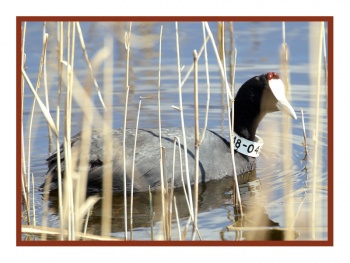- Fulica cristata
Identification
Length 38–45 cm (15–18 in)
Adult -Largely dark slaty gray with black head and neck and white facial shield; in breeding plumage, the top of the shield has two small red "balls" or "horns". However these knobs are reduced during the non-breeding season.
Juvenile - Paler than adult, with a white breast, and lacks the facial shield; the adult's black plumage develops when about 3-4 months old, but the white shield is only fully developed at about one year old.
Similar Species
Similar to the Eurasian Coot (F. atra) which lacks the red knobs. The knobs may not always be obvious in the field. Note that the black feathering between the shield and the bill is more rounded in Red-knobbed Coot. In Eurasian Coot the bill feathering comes to an acute angled point at the side of the bill.
Distribution
Sub-Saharan Africa including Madagascar, and disjunct in Morocco and southernmost Spain.
Taxonomy
This is a monotypic species[1].
Habitat

Photo © by Ken Billington
S'Albufera National Park, Mallorca, Spain, 25 February 2006
Freshwater lakes and ponds.
Behaviour
Reluctant to fly. When taking off it runs across the water with much splashing.
Breeding
Monogamous. It builds a nest of dead reeds near the water's edge or afloat, up to 8 eggs are laid.
Diet
Mainly eats plant material, supplemented with molluscs, crustaceans and insects; occasionally the eggs of other water birds.
Vocalisation
Generally noisy. Calls include a fast "kerrre" and a harsh "ka-haa."
Movements
Part of the population is resident, but most are nomadic, moving in response to rainfall. Numbers fluctuate regardless of rainfall indicating some movement even in dry years.
References
- Clements, J. F., T. S. Schulenberg, M. J. Iliff, D. Roberson, T. A. Fredericks, B. L. Sullivan, and C. L. Wood. 2017. The eBird/Clements checklist of birds of the world: v2017, with updates to August 2017. Downloaded from http://www.birds.cornell.edu/clementschecklist/download/
- Taylor, B. (2018). Red-knobbed Coot (Fulica cristata). In: del Hoyo, J., Elliott, A., Sargatal, J., Christie, D.A. & de Juana, E. (eds.). Handbook of the Birds of the World Alive. Lynx Edicions, Barcelona. (retrieved from https://www.hbw.com/node/53694 on 4 July 2018).
- Hockey, PAR, WRJ Dean, and PG Ryan, eds. 2005. Roberts' Birds of Southern Africa. 7th ed. Cape Town: John Voelcker Bird Book Fund. ISBN 978-0620340533
- Sinclair, I., Hockey, P.A.R., and Arlott, N. (2005). The Larger Illustrated Guide to Birds of Southern Africa. Struik, Cape Town. ISBN 978-1775840992
Recommended Citation
- BirdForum Opus contributors. (2024) Red-knobbed Coot. In: BirdForum, the forum for wild birds and birding. Retrieved 26 December 2024 from https://www.birdforum.net/opus/Red-knobbed_Coot
External Links





